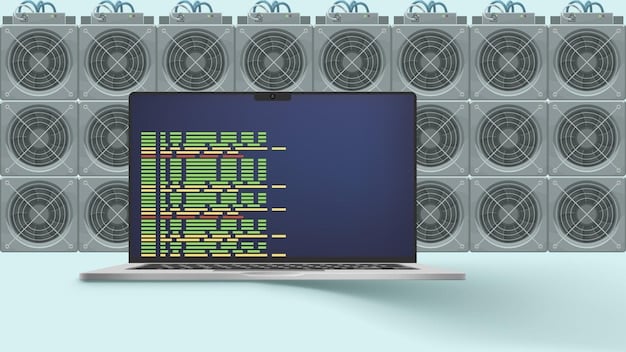Building Real-Time Dashboards with Socket.IO and React in 2025

Building a real-time dashboard using Socket.IO and React provides US developers with a powerful tool for visualizing data, fostering user engagement, and gaining insights, making it an essential skill in 2025 for creating dynamic applications.
In the fast-evolving landscape of web development, creating dynamic and interactive user experiences is paramount. If you’re a US developer looking to stay ahead in 2025, mastering the art of building a real-time dashboard with Socket.IO and React: A Comprehensive Guide for US Developers in 2025 is crucial. This guide will equip you with the knowledge and practical steps to build robust, real-time dashboards.
Understanding Real-Time Dashboards
Real-time dashboards are essential tools that present up-to-the-minute data in an easily digestible format. They offer immediate insights, allowing businesses and developers to react quickly to changing conditions. Understanding their purpose and benefits is the first step in creating effective dashboards.
What is a Real-Time Dashboard?
A real-time dashboard displays information that is updated automatically as new data becomes available. Unlike traditional dashboards that require manual refreshing, real-time dashboards provide a continuous stream of information.
Benefits of Using Real-Time Dashboards
Real-time dashboards offer numerous benefits, including improved decision-making, enhanced user engagement, and increased operational efficiency. By providing instant access to critical data, these dashboards enable users to make informed decisions and respond promptly to emerging trends.
- Improved decision-making: Immediate access to data allows for quicker and more informed decisions.
- Enhanced user engagement: Real-time updates keep users engaged and informed.
- Increased operational efficiency: Automation reduces the need for manual data collection and analysis.
- Better monitoring: Continuous data streams enable better monitoring of key performance indicators (KPIs).
In summary, understanding the essence and advantages of real-time dashboards is foundational for any developer aiming to leverage these powerful tools in their projects. By creating dashboards that provide immediate insights and improve user engagement, developers can significantly enhance the value of their applications.

Introduction to Socket.IO
Socket.IO is a JavaScript library that enables real-time, bidirectional communication between web clients and servers. It simplifies the process of building real-time applications by providing a high-level API over WebSockets, which are a communication protocol that allows for persistent connections.
Why Use Socket.IO?
Socket.IO abstracts away the complexities of WebSockets, making it easier to implement real-time features in web applications. It provides automatic reconnection, fallback to HTTP long-polling, and support for binary data.
Key Features of Socket.IO
Socket.IO offers several key features that make it a popular choice for real-time applications. These include:
- Real-time communication: Enables instant data transfer between clients and servers.
- Bidirectional communication: Allows for both clients and servers to send and receive data simultaneously.
- Automatic reconnection: Automatically reconnects clients in case of disconnection.
- Fallback to HTTP long-polling: Falls back to HTTP long-polling if WebSockets are not supported.
In conclusion, Socket.IO provides a robust and user-friendly solution for handling real-time communication in web applications. By simplifying the complexities of WebSockets and offering essential features like automatic reconnection, Socket.IO enables developers to focus on building engaging and responsive applications.
Setting Up Your React Environment
Before diving into building the real-time dashboard, it’s essential to have a well-configured React environment. This involves setting up Node.js, creating a new React application, and installing the necessary dependencies.
Installing Node.js and npm
Node.js is required to run React applications and manage dependencies using npm (Node Package Manager). Ensure you have Node.js installed by downloading it from the official website.
Creating a New React Application
Use Create React App to quickly set up a new React project. This tool provides a modern build setup with no configuration needed.
npx create-react-app real-time-dashboard
cd real-time-dashboard
Installing Dependencies
Install the necessary dependencies for the dashboard, including Socket.IO client and any charting libraries you plan to use.
npm install socket.io-client chart.js react-chartjs-2
In summary, properly setting up the React environment involves installing Node.js, creating a React application, and installing the necessary dependencies. With these steps completed, developers can proceed with confidence to build their real-time dashboards.
Building the Server-Side with Node.js and Socket.IO
The server-side component is crucial for handling real-time data and communication with clients. Node.js, combined with Socket.IO, provides a powerful and efficient way to manage this.
Setting Up a Node.js Server
Create a new Node.js project and install the Socket.IO package.
npm init -y
npm install socket.io
Implementing Socket.IO Functionality
Implement the Socket.IO functionality to handle client connections, emit data, and manage disconnections.
const http = require('http');
const socketIO = require('socket.io');
const server = http.createServer();
const io = socketIO(server, {
cors: {
origin: "http://localhost:3000",
methods: ["GET", "POST"]
}
});
io.on('connection', (socket) => {
console.log('Client connected');
socket.on('disconnect', () => {
console.log('Client disconnected');
});
});
const port = 4000;
server.listen(port, () => {
console.log(`Server listening on port ${port}`);
});
Emitting Real-Time Data
Set up the server to emit real-time data at regular intervals. This data could come from various sources, such as databases, APIs, or sensors.
setInterval(() => {
const data = {
temperature: Math.random() * 30,
humidity: Math.random() * 100,
};
io.emit('realtimeData', data);
}, 1000);
In conclusion, building the server-side with Node.js and Socket.IO involves setting up the server, implementing Socket.IO functionality, and emitting real-time data. This server acts as the backbone of the real-time dashboard, providing the necessary data stream to the client.

Creating the React Client
The React client is responsible for connecting to the Socket.IO server and displaying the real-time data on the dashboard. This involves setting up the client-side connection, receiving data, and updating the UI.
Connecting to the Socket.IO Server
Establish a connection to the Socket.IO server using the socket.io-client library.
import socketIOClient from "socket.io-client";
const ENDPOINT = "http://localhost:4000";
const socket = socketIOClient(ENDPOINT);
Receiving and Displaying Data
Receive real-time data from the server and update the React component’s state to display the data on the dashboard.
import React, { useState, useEffect } from 'react';
import socketIOClient from "socket.io-client";
const ENDPOINT = "http://localhost:4000";
function App() {
const [data, setData] = useState({});
useEffect(() => {
const socket = socketIOClient(ENDPOINT);
socket.on("realtimeData", data => {
setData(data);
});
return () => socket.disconnect();
}, []);
return (
Real-Time Dashboard
Temperature: {data.temperature}°C
Humidity: {data.humidity}%
);
}
export default App;
Building the User Interface
Create an intuitive and visually appealing user interface for the dashboard. This may involve using charting libraries to display data in graphs and charts.
- Use responsive design principles to ensure the dashboard looks good on all devices.
- Incorporate data visualization libraries to present data effectively.
- Provide clear and concise labels for all data points.
In conclusion, creating the React client involves connecting to the Socket.IO server, receiving and displaying real-time data, and building an intuitive user interface. By efficiently managing the client-side components, developers can create engaging and responsive dashboards that provide valuable insights to users.
Enhancing the Dashboard with Visualization
Data visualization is essential for making real-time dashboards effective and user-friendly. By using charting libraries, developers can present data in a clear and concise manner, enabling users to quickly grasp key trends and insights.
Choosing a Charting Library
Select a charting library that suits your needs. Popular options include Chart.js, Recharts, and Nivo. Each library offers different features, customization options, and performance characteristics.
Integrating Charts into Your Dashboard
Integrate the chosen charting library into your React dashboard. This involves installing the necessary packages and configuring the charts to display real-time data.
import { Line } from 'react-chartjs-2';
const data = {
labels: ['Now', 'Future'],
datasets: [
{
label: 'Temperature',
data: [data.temperature, data.temperature + Math.random() * 5],
fill: false,
backgroundColor: 'rgb(255, 99, 132)',
borderColor: 'rgba(255, 99, 132, 0.2)',
},
],
};
const options = {
scales: {
yAxes: [
{
ticks: {
beginAtZero: true,
},
},
],
},
};
function App() {
// ... (previous code)
return (
Real-Time Dashboard
Customizing Chart Appearance
Customize the appearance of your charts to match the overall design of your dashboard. This may involve changing colors, fonts, and other visual elements.
In summary, enhancing the dashboard with visualization involves choosing a charting library, integrating charts into the dashboard, and customizing the chart appearance. By effectively visualizing real-time data, developers can create dashboards that provide clear and actionable insights to users.
| Key Point | Brief Description |
|---|---|
| 📊 Real-Time Data | Dashboard displays live, up-to-the-minute information. |
| 🔌 Socket.IO | Enables bidirectional communication between client and server. |
| ⚛️ React Client | Connects to the Socket.IO server and renders the data. |
| 📈 Data Visualization | Using charts to display real-time data effectively. |
[FAQ Section]
Frequently Asked Questions
A real-time dashboard’s primary goal is to provide immediate insights into data, allowing users to make informed decisions and quickly respond to changes or emerging trends.
Socket.IO simplifies real-time bidirectional communication, handles WebSocket complexities, and offers automatic reconnection and fallback mechanisms, making it reliable and easy to use.
Setting up a React environment involves installing Node.js, creating a new React application using Create React App, and installing essential dependencies like Socket.IO client.
Popular charting libraries for React dashboards include Chart.js, Recharts, and Nivo. Each offers unique features and customization options to visualize data effectively.
Yes, real-time dashboards can significantly improve business efficiency by providing instant access to critical data, enabling quicker decision-making, and enhancing overall operational monitoring.
Conclusion
In conclusion, mastering the art of building a real-time dashboard with Socket.IO and React: A Comprehensive Guide for US Developers in 2025 is an invaluable skill for US developers. By leveraging the capabilities of Socket.IO for real-time communication and React for creating dynamic user interfaces, developers can build dashboards that provide immediate insights, foster user engagement, and drive informed decision-making.





